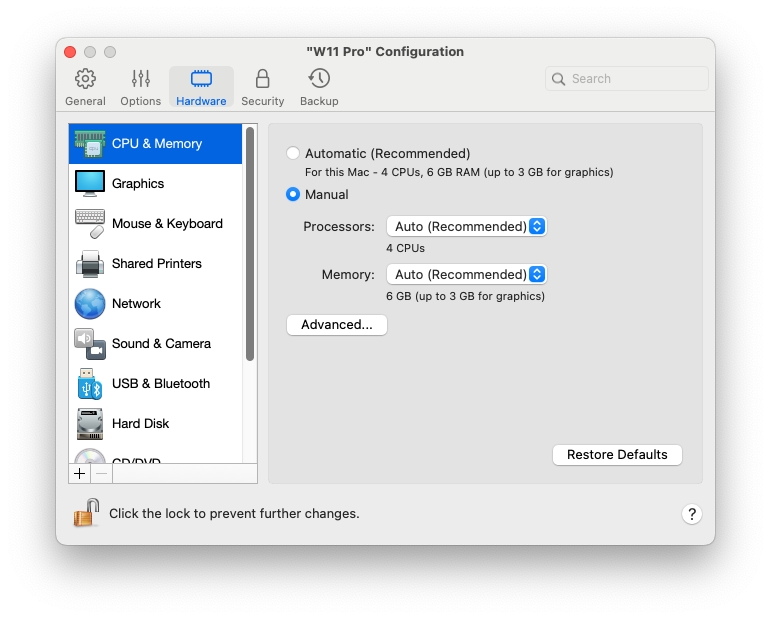CPU & Memory Settings
In the CPU & Memory pane, you can view and configure the CPU- and memory-related settings.
To open these settings, choose Actions > Configure > Hardware, then click CPU & Memory.

CPU and memory allocation
If you're using Windows 10 or later, Parallels Desktop allocates the required number of CPUs and amount of memory to the virtual machine automatically so that you get the optimal performance and good experience. It is recommended that you use the default settings.
However, if you are not satisfied with the virtual machine's performance, you can manually specify how much CPU and memory can be consumed by your virtual machine. Select Manual and choose the desired values from the corresponding fields.
Virtual machines created and run in Parallels Desktop for Mac Standard Edition are limited to 4 vCPU cores and 8GB of vRAM. For the Pro and Business Editions, the limitations are as follows:
• Up to 32 vCPU cores for Intel Macs and up to 18 vCPU cores for Apple silicon Macs (maximum tested number);
• Up to 128GB of RAM for Intel Macs; for Apple Silicon Macs, it is:
• Up to 63GB if the host runs macOS 12 Monterey and/or doesn’t implement the 39-bit intermediate address space (base versions of M1 and M2 chips);
• Up to 128GB in all other cases.
Please note that more is not always better. First, try to work with your virtual machine using the default settings. If it is slow, try to add more memory and/or increase the number of CPUs. If the virtual machine becomes faster, it's ok. If not, try to change the CPU and memory allocation some other way. It is not easy to provide more straightforward instructions because the virtual machine performance depends on the Mac's hardware, which apps are running on your Mac, which apps are running in the virtual machine, etc.
If you have a virtual machine with Windows 8.1 or earlier, Linux or macOS operating system, you can choose how much CPU and memory can be consumed by the virtual machine using the Processors and Memory menus.
Extended memory limit This option is available only in Parallels Desktop for Mac Pro and Business Editions installed on a Mac with an Intel processor
This option allows you to allocate more memory to a virtual machine than your Mac physically has. Use this option with care (or your system may significantly slow down) and only on rare occasions, e.g., when you're trying to set up a database on a virtual machine and the installer claims that you don't have enough memory.
Hypervisor
This menu is available only on Mac computers equipped with an Intel processor. Virtual machines created on Apple Silicon Macs always use the Apple hypervisor
In this menu, you can choose whether to use the hypervisor from Parallels or from Apple. It is recommended that you use the Parallels hypervisor.
Adaptive Hypervisor
Select this option to set Parallels Desktop to automatically optimize performance for the virtual machine or macOS depending on which application you're working with at the moment. When you're using a virtual machine app, more resources are given to the virtual machine, and when you're using a macOS application, more resources are given to macOS.
Enable nested virtualization
This menu is available only in Parallels Desktop for Mac Pro and Business Editions installed on a Mac with an Intel processor provided that the virtual machine is configured to use the Parallels hypervisor.
Select this option to enable nested virtualization support. Parallels Desktop allows you to run:
Hyper-V virtual machines inside Windows 8 or newer, and Windows Server 2012 or newer virtual machines;
Parallels Desktop inside a macOS virtual machine;
VMware ESXi virtual machines;
Xen and kernel-based virtual machines in versions of Linux that support Xen and KVM.
Note: Running a virtual machine within a virtual machine may dramatically slow down the macOS and virtual machine performance.
If you use Parallels virtual machines to build, debug, and test applications, enable nested virtualization to install and work in:
Android emulator for Visual Studio;
iPhone emulator for Visual Studio;
Xamarin.Android;
Android Studio;
Embarcadero RAD Studio;
Docker for Windows;
Microsoft Visual Studio + TwinCat 3 (support for TwinCat 3 is being tested, and there may be some bugs).
Was this helpful?